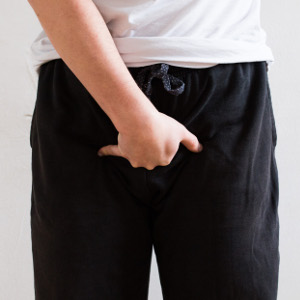Having a good posture is something that we all know is important somehow, but we rarely investigate what good posture actually is, any why it is good. In this post, I’m going to present a few guidelines that I find particularly useful. You can use them both as imagery to improve you posture in a gentle fashion, gradually reforging your self-image, and to check where you’re currently at, or even “force” your body in the “right” position, to have a feel for the position.
 In short
In short
We want to align five points on top of the ankle joints: the knees, the hip joints, the front of the spine where it is furthest back, the shoulder joints, and the joint between the skull and the spine. The details on where these points are exactly follow.
Note that (except for the spine related one), all of these points are at least an inch wide, so this is not very exact, but it fits our purpose well enough. However, they all require some precision regarding what exactly we’re talking about, and where these elements are.
The ankle joint
This is the joint between your shin (tibia and fibula) and the very complex construct that is your foot (the bone concerned by said joint is the talus). These bone articulate in a less than trivial fashion, but for our purpose of standing posture, saying that the joint is located between our malleoli (the bony protrusions either side of our ankle) is perfectly adapted. Another point of interest of the ankle is the front of it, which you can locate by palpating the front of the tibia, then going down until you reach a dip.
The knee
Nothing surprising here. For our considerations, we will care about the front-and-back middle of the join. This corresponds roughly to the point where the bony part of the knee is the widest.
The hip joint
There often is a lot of confusion regarding the placement of the hip joint, mostly because we use “hips” as a throwaway for pretty much any part of our pelvic region (heck, I even heard someone say “hip” as a euphemism to designate the buttock). So, to locate your hip joint, first notice the fold between your leg and the rest of your body. Then, make the universal hand gesture for “phone”, and place your pinky and thumb on either fold (one on the left, the other on the right) so that they’re roughly at the same height. Here are your hip joint! They are big joints though, so they expand almost an inch in either direction. They’re quite superficially locate under the skin (so that we can fold!), but due to their size, the centre of the ball in this ball-and-socket joint is about two inches deep under the skin. To align it on top of the ankle, the easiest is to think of aligning the skin mark for it (the crease of the groin) with the front of the ankle, located in he paragraph above.
The front of the spine
This one is mostly an imagery tool, and cannot be precisely located by palpating areas close to the skin. Don’t worry too much about it though, because if the other points are well aligned and you take this one too far back, you’ll fall backwards anyway.
The shoulder joint
This is also a rather big ball-and-socket joint, but it comes with an easy marker for the front-and-back location of its centre: if you put your hand flat on your shoulder, you’ll feel various nooks and crannies, with one point that is more prominent than the others. This is the marker we’re looking for! It’s closer to the midline than the joint is, but for our purposes, that is irrelevant. For biomechanical reasons, I often think of this point being suspended to the next one, which I’ll align over the hips.
The joint between the skull and the spine
This area also tends to be misplaced by many people. Thankfully though, it is really easy to locate! It’s just under our ears, on the line between the two earlobes.
Why these landmarks?
The first choice was the ankle. This is the first articulation on top of our base that is our feet. Therefore, if we want our bones to bear our weight, it makes sense that we want to align them vertically on top of that base. This demand dictates all the other choices.
I use these guidelines myself as an imagery tool and as a check, and they’ve helped me a lot. They come from various sources (mostly idokinesis and taiji) as well as personal considerations on the shape and function of our body, and experiment. Note that this post is only concerned with front-and-back alignment. There are important up-and-down concerns, too, that will get addressed in due time.
Continue reading: Sitting Posture, Imagery for Posture – Shoulder Crosses 2, 5 Daily Opportunities to Perfect your Posture.
This article also exists in French.
Want more like this?
Check out the following blogs from massage therapists I know from around London:- On The Run Health and Fitness on running, nutrition and sports massage.
- The Soma Room on sports massage and exercise.








No Responses